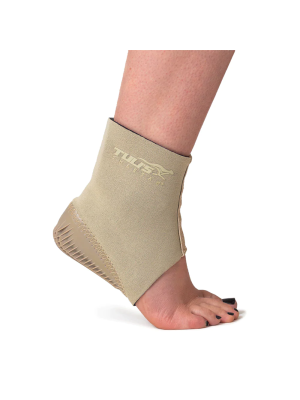FREE DELIVERY on all UK orders over £4.50 Find out more
Tuli's heavy duty gel Heel Cups
Heavy Duty Gel Heel Cups, provide additional thickness and support for athletic performance.
Highlights:
- Shock-absorbing heel cups relieve heel pain
- Ideal for plantar fasciitis
- Improve athletic performance
- Flexible enough to fit gym shoes
Best used for:
Gymnastics, Tumbling, Trampolining, Sports aerobics, Cheerleading
Sizing for the Best Fit
Small - Men's shoe sizes 3 and under. Women's shoe sizes 4 and under.
Regular - Men's shoe sizes 4 and up. Women's shoe sizes 5 and up.
Heavy Duty Gel Heel Cups, provide additional thickness and support for athletic performance.
When can I use Heavy Duty Gel Heel Cups?
Use the gel heel cups to provide relief from heel pain, Plantar fasciitis, heel spur, knee and ankle pain as well as back pain. The heel cups are ideal for prolonged periods of standing, as well as for sporting activities.
Two Styles Available
Classic Gel Heel Cups - flexible enough for any shoe.
Heavy Duty Gel Heel Cups (flexible too)- provides additional thickness and support for athletic performance.
Lifetime Warranty
Tuli’s uses the longest-lasting and best-performing materials available so they can be backed by our industry-leading lifetime warranty.
Sizing for the Best Fit
Small - Men's shoe sizes 3 and under. Women's shoe sizes 4 and under.
Regular - Men's shoe sizes 4 and up. Women's shoe sizes 5 and up.
Risk Factors for Gymnastics and Foot Pain
Gymnasts are at particular risk for developing heel pain for a few different reasons. Understanding these risk factors can help you plan plenty of rest and foot care into days and weeks that include activities that place particular strain on the plantar fascia:
Injuries to the feet or legs during practice or competitions can lead to plantar fasciitis, even if the injury wasn’t directly to the foot or fascia. Injuries to the feet, legs, hips, knees, or ankles can cause biomechanical imbalances that change the gait put extra strain on the plantar fascia. Injuries can also lead to decreased flexibility and muscle strength in the muscle groups and ligaments that support the plantar fascia.
Repetitive movements (especially high impact jumps and landings) can lead to flattening and small tears in the plantar fascia. This repetitive impact can also cause the heel’s protective fatty pad to wear and grow thin, leading to increasing heel pain and sensitivity.
Because most tumbling and gymnastics routines are done barefoot, the arch can’t rely on any extra support from shoes. This means that the arch alone is left to absorb the impact of any high-impact landings, jumps, or running.
During intense periods of preparation for a meet, the arch may not be able to repair damage and rest properly, leading to compounding injuries and severe strain.
Since gymnastics is most often a sport performed by young people, it’s possible that the heel pain is not plantar fasciitis at all, but Sever’s disease.
It’s important to pay attention to these risk factors, and stay alert to any pain that may develop in your heels or feet after a competition or practice.

 FR
FR UA
UA





